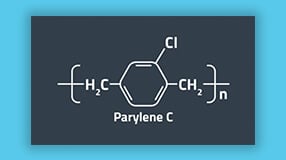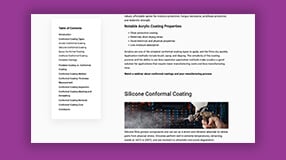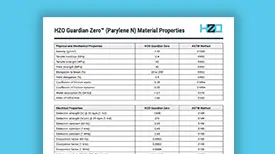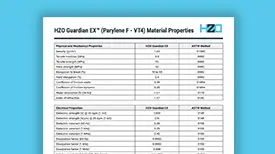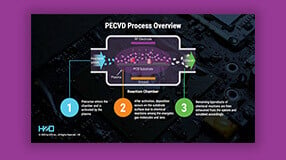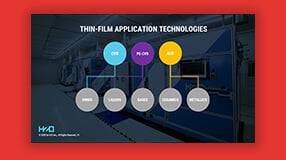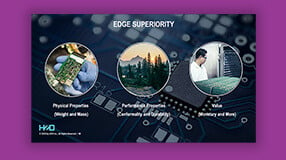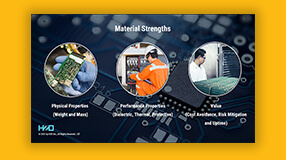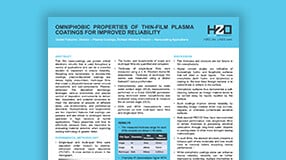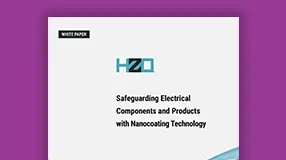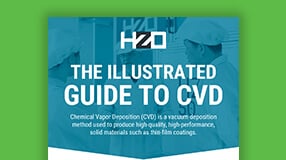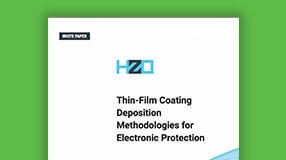PECVD vs CVD – Chemical Vapor Deposition Overview

Download our white paper on choosing the correct coating methodology for your next project:
Chemical Vapor Deposition Methods
Chemical vapor deposition (CVD) methods (including but not limited to CVD, PECVD, and atomic layer deposition, ALD) are done under vacuum, well below atmospheric pressure, as the process deposits layers of material molecule-by-molecule or atom-by-atom. With these techniques, thin-film layers can be deposited in the range of nanometers to sub-20-micron, compared to traditional deposition, which yields coatings at 50-500 microns.
No matter the method, vapor deposition produces coatings that alter the substrates’ electrical, mechanical, optical, thermal, and corrosion-resistance properties. The resulting dry coatings are durable and have reached optimal properties without curing at the end of the production cycle.
Below is an overview of the chemical vapor deposition process.
Overview of the Chemical Vapor Deposition Process
The CVD process deposits materials, including Parylene, in a vacuum chamber by vapor deposition polymerization. The item to be coated is exposed to one or more precursors, which decompose or react on the surface. In the instance of Parylene, a solid dimer is vaporized to gas. Before entering the deposition chamber, the gas travels through a pyrolysis chamber that cracks the dimer into two di-radical monomers. The monomers adsorb onto the substrate as a polymer.

Chemical vapor deposition is used to augment substrate surfaces in ways that traditional modification techniques cannot. Polymerization by CVD allows for thin coatings with properties such as lubricity, weather resistance, and hydrophobicity.
Chemical vapor deposition is a repeatable process that produces consistent coverage and reliable results. Applications include:
- Automotive electronics and sensors
- Smart home security devices
- Consumer electronics, including smartphones, hearables, and wearables
- HVAC sensors
- Smart city utility meters
- Biosensors
Many hybrid application techniques arise from CVD, evolving to modify the properties of fabricated thin films. Among these variants, PECVD is a method that can extend the applicability of the technique for reactive and inorganic materials, inert materials, and various precursors. This technique is discussed below.
Overview of the Plasma-Enhanced Chemical Vapor Deposition Process
Plasma-enhanced chemical vapor deposition is a variant of CVD; however, it uses plasma energy instead of only thermal energy to deposit thin films. The plasma is typically created by radio frequency, direct current, or microwave discharge that energizes reactant gases, such as silane or oxygen, to form a plasma. The deposition equipment uses a mixture of ions, free electrons, radicals, excited atoms, and molecules to deposit thin-film coatings to the substrate. Parts in the chamber are bombarded with energetic ions (plasma) that form a thin-film layer on the surface made from metals, oxides, nitrides, and/or polymers (fluorocarbons, hydrocarbons, silicones).

PECVD-deposited films have excellent physical properties because they are uniform, highly cross-linked, and generally resistant to chemical and thermal changes. Plasma-applied polymers are extensively used in optical coating and dielectric films due to their lower cost and higher efficiency properties. Offering excellent control of material properties (stress, refractive index, hardness), PECVD also produces films used in the semiconductor industry for device encapsulation, surface passivation, and isolation of conductive layers.
Different film compositions can easily be adjusted to produce organic thin films on large substrates (glass and silicon) with varying chemical, thermal, optical, electrical, and mechanical properties. PECVD has also recently been used for many biological applications, including medical device protection, and is also used to avoid corrosion in optical and dielectric devices.
This nanocoating process can use various materials as coatings, including metals, oxides, or silicon, which may offer more flexibility than CVD. Applications include:
- Fabrication of electronic devices to isolate multiple conductive layers, capacitors, and for surface passivation
- Solar cells, semiconductor devices, and optically active device applications due to optical, mechanical, and electrical properties
- Processing of printable electronic devices due to high process efficiency, large-scale patternability, lower cost, and environmentally friendly nature
- SiN (silicon nitride) PECVD films are used for semiconductor applications due to higher capacitance density, breakdown voltage, and particle performance.
- SiC (silicon carbide) PECVD films have demonstrated promise in developing high-temperature withstanding MEMs devices.
CVD Benefits
When used with Parylene, CVD brings many benefits to the table, including:
- Ultimate thin-film barrier material for liquid water, water vapor, and harsh chemical corrosion (acid, alkali, organic reagents)
- Excellent dielectric strength to provide dielectric and insulative protection across an extensive range of frequencies
- Highly conformal and adherent to many surfaces (metals, glasses, plastics, silicon, ceramics)
- Entirely non-toxic (safe for all human contact, including implantable devices) and green (non-hazardous processing)
CVD Drawbacks
In comparison with PECVD, CVD can have the following drawbacks:
- Higher cost: long deposition time (10-20 hrs) need for masking/demasking (80%-line cost), and high precursor (dimer) cost
- Relatively thick film (typically 10µm minimum thickness needed for high integrity pinhole-free conformal coating)
- Limited operating range/life due to the aging effects of heat (>50°C), oxygen (air), and UV (sunlight) exposure
- Low wear resistance and mechanical durability limits use on exterior surfaces (cases, enclosures)
PECVD Benefits
PECVD offers the following benefits:
- Ability to create “nano”-thin barrier films (50nm+) with low stress (room temperature process)
- Lower cost: due to fast deposition times (accelerated by RF field) and relatively low cost/low use precursor materials
- No need for masking/demasking to prevent coating on non-target part areas: the coating may be shielded using the part-holders
- High tailorability: recipe changes facilitate diverse coating properties, including hydrophobic surfaces, UV protection, oxygen resistance, reworkability, and more
PECVD Drawbacks
In comparison with CVD, PECVD can have the following drawbacks:
- Barrier performance is weaker than Parylene and highly dependent on the film thickness, layer count, and plasma type.
- Limited wear resistance: materials are typically soft (enables rework but exacerbates handling issues).
- Some coatings may be halogenated, raising health and environmental concerns.
Although this article has provided an overview of CVD and PECVD, it is only a high-level discussion. Chemical vapor deposition processes are a good choice for thin-film deposition, but selecting the proper method takes significant experience and technical acumen from a domain expert. HZO offers highly customizable protection solutions with CVD processes. If you have difficulty deciding which thin-film deposition method to use, contact us today to consult with our engineers.
Parylene CVD vs. ALD vs. PECVD: Here's What R&D Leaders Should Know
Parylene Conformal Coatings - Parylene Conformality Explained
IoT - Coating Consistency is Key
Multi-skilled marketing director with more than 18 years’ experience in growing the customers and brands of diverse companies. Ability to meet diverse marketing challenges by utilizing experience, skills, and creativity. Expertise in demand generation, content, branding, design, and communications.
Additional Resources

Learn How To Incorporate Conformal Coating Into Your Manufacturing Process

Learn About the Thin Film Coating Properties and Processes In Our Webinar



